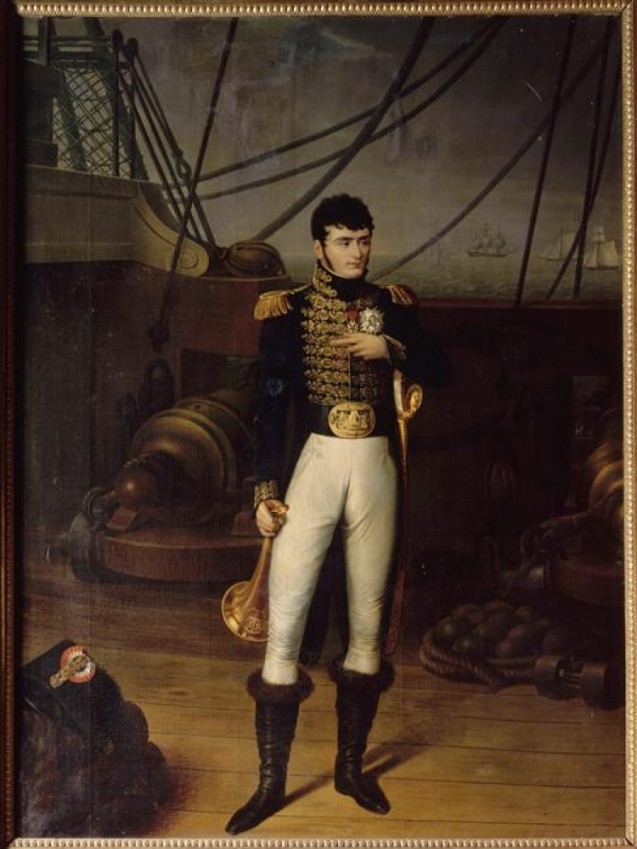This portrait of Jerome Bonaparte (1784-1860), Napoleon’s younger brother, depicts a scene from his early adult life (from 1800 to 1806) spent in the French navy. It was painted by the prolific Flemish portraitist François-Joseph Kinson (1771–1839) (or Kinsoen with the original Flemish spelling) who would later be chosen as Jerome’s official painter when the latter was King of Westphalia. Kinson had settled in Paris from 1799 after exhibiting there and was to work for the court of Napoleon as well as for the rich and famous of the age.
Jerome was only three months old when his father died, and it is thought that as a result of this, his mother, Letizia (née Ramolino) was less strict with him than she had been with his elder siblings. Napoleon (fifteen years his elder) would become a pseudo-father figure for the youngest Bonaparte, and in this role he arranged for the education of his brother. When Jerome (a turbulent youth) was aged fifteen, following a duel – probably over a woman – with Louis-Alexandre Davout (brother of the future Marechal), Napoleon decided that his brother should go into the navy. It is not clear if this was a sanction for his behavior, or a strategy to put the youth at a safe distance from the hedonistic lifestyle of the French capital, or simply to launch him into a military career, in which he might have a hope of achieving some sort of success, since by all accounts he was not of a particularly intellectual disposition. What is certain is that the First Consul’s younger brother made rapid progress up the ranks (most likely through his family connections rather than as a result of exceptional talent or hard work), and by late 1802, he was placed in command of the brig l’Epervier headed for the Caribbean, and shortly after (on 25 Nivôse Year XI or 15 January 1803) he was promoted to Lieutenant by the First Consul.
Though this painting is undated, details on the painting as well as chronology and circumstance would suggest that this representation most likely depicts the moment in the naval career of Jerome when, as a young Commander (after 21 May 1805), he undertook two consecutive missions between his return to Europe in April 1805 and the end of the following year. Jerome is dressed in the uniform of an officer (but with curious anomalies detailed below). He is shown standing on the bridge of a warship, as is clear from the presence of canon and cannonballs. We know that, in July 1805, Jerome was sent by Napoleon, now Emperor, to Algiers in charge of a warship La Pomone and the Genoese naval Division in order to liberate the Genoese, Italian and French prisoners held there. At the end of the same year, Admiral Willaumez sent him in command of the 74-gun Vétéran as part of a campaign in the Atlantic. Jerome was in fact promoted to the rank of Commander on 1 Prairial, Year XI (21 May 1805), then Captain (1 November 1805) rising further to “Contre-amiral” on 18 September 1806. These facts would place the execution of this painting between May 1806 and September 1806. It is true that the presence of the Grande Plaque of the Légion d’Honneur (which Napoleon gave to Jerome on 12 September 1806 on his return from the atlantic mission) could suggest a terminus post quem for the painting. However, an earlier date remains more likely. Jerome is clearly dressed as an officer; however the voice-trumpet is the attribute of a commander and not an admiral. What is more, the elements such as the belt plaque (similar in style to that of an officer such as Contre-Amiral according to an article 1er of the decree of 7 Prairiel XII) and the Grande Plaque could quite easily have been added later, after 12 September 1806.
It is quite probable that Kinson composed this painting based on other representations of Jerome or possibly from sketches; the decor is most likely the product of the artist’s imagination; nothing allows us to identify it as a particular ship. In his right hand Jerome holds a voice-trumpet – an essential piece of equipement used by the ship’s captain to call out orders to the crew (normally marked with the vessel’s name). This one, although it clearly bears the letters J and B, fails to identify the name of the vessel to which it belongs. The uniform includes various elements of fantasy such as the elaborately decorated plaque on the belt, the fur-lined boots and indeed the sabre which, with its seahorse and shell decorations and mother-of-pearl inlay, resembles more a ceremonial weapon than a genuine naval captain’s sword. We might therefore assume that Kinson’s representation was intended more as a symbolic one rather than an accurate representation of a particular event.
Jerome’s extraordinary rise was to continue at the end of 1806 when he left the navy to join the Grande Armée, soon becoming General of Division (equivalent to the highest naval grade of Vice Admiral), and finally reaching the top in 1807 with the rank of “King of Westphalia”. Kinson was to paint Jerome several more times, notably as King of Westphalia, in the uniform of a Westphalian General, and standing in front of the Westphalian royal palace of Napoleonshöhe with his second wife, Catherine of Wurttemberg, chosen for him by Napoleon. After the fall of the Empire, Kinson pursued a successful career as a court painter until 1830.
This portrait of Jerome recalling his naval career was owned by his mother Letizia (see her own portrait by Kinson) until her death in 1836 whereafter it entered the collection of Cardinal Fesch and today resides in the Town Hall of Ajaccio, Corsica.
Rebecca Young, June 2017
Find out more about Jerome’s naval career in an extensive article (in French): Jérôme Bonaparte, officier de Marine, by Patrick Le Carvèse, in Napoléonica. La Revue.


